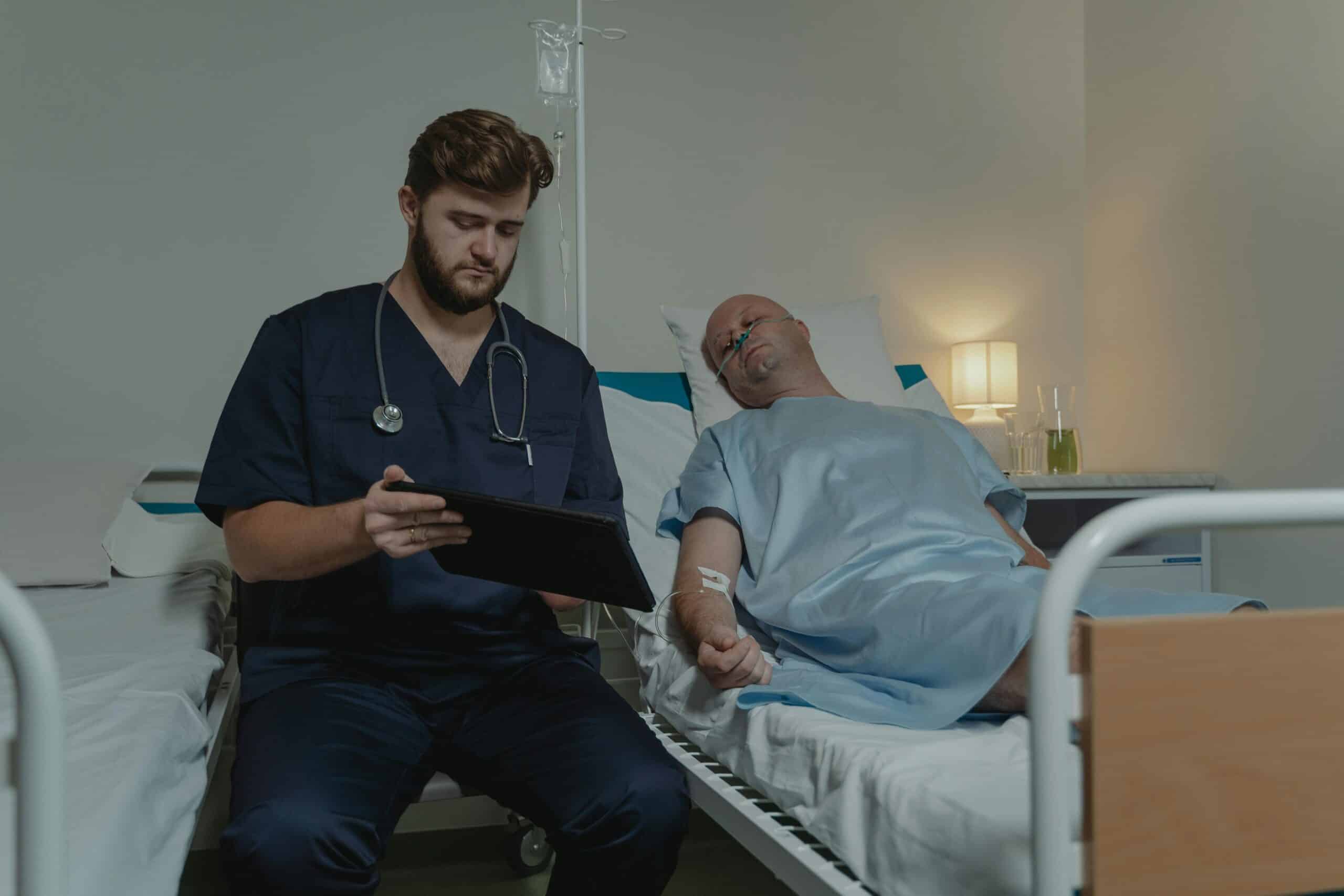Making a Nursing Diagnosis for RSV

Impacting people of all ages, respiratory viruses can spread quickly and easily from person to person, highlighting the need for a heightened awareness of how to protect yourself and your patients. This is particularly true in hospitals where illnesses like respiratory syncytial virus (RSV) can spread quickly to compromised people in close proximity.
The nurse’s role in managing and preventing the spread of RSV is multidimensional. It includes knowing best practices for health and safety as well as understanding key symptoms so an effective nursing diagnosis for RSV can be made as early as possible. The changing landscape of respiratory illnesses means all frontline healthcare professionals have to stay up to date, and courses like Solving the Viral Mystery: COVID-19, Influenza, and Beyond give them the tools to make life-saving decisions quickly.
Here are the facts every nurse should know about RSV and guidance for making an accurate diagnosis in any healthcare setting.
RSV Overview
Respiratory syncytial virus affects people of all ages, but young children and older adults are disproportionately vulnerable to hospitalization. Early detection and management of the symptoms related to RSV are key to staying ahead of a worsening viral process that might lead to serious complications.
RSV in Babies and Children
RSV often presents symptoms that are similar to the common cold, making it easy to misdiagnose in young children and infants. However once the disease takes hold, it can rapidly evolve into a serious respiratory condition that requires hospitalization.
In the early stages, children typically exhibit a runny nose, decreased appetite, and a mild cough that appears around day 3 of the illness. As the virus gains momentum, symptoms often intensify with sneezing, fever, and worsening cough, sometimes leading to more serious complications like bronchiolitis or pneumonia.
The severity of illness is closely related to age and the presence of underlying health conditions. Children most at risk for experiencing severe symptoms of RSV include:
- Premature infants
- Children with weakened immune systems
- Children with neuromuscular disorders, congenital anomalies, and those who have difficulty swallowing or clearing secretions
- Children with severe cystic fibrosis
However, while these situations all represent elevated risk, infants—regardless of overall health—are by far the most vulnerable, with 2-3% admitted to the hospital every year.
RSV Symptoms in Older Adults
Because RSV symptoms are often mistaken for a common respiratory tract infection, many cases in adults go completely undiagnosed. Rhinorrhea, sore throat, cough, headache, fatigue, and fever are all very common with RSV, and those with mild cases typically see relief in 1–2 weeks.
However, for those 65 and older, these symptoms can quickly turn into diseases like pneumonia and bronchitis, and complications from RSV result in up to 160,000 hospitalizations each year. Some need care in the ICU, and RSV is responsible for 6,000-10,000 deaths per year in this population.
Nurses should be especially cautious in treating older patients with cold-like symptoms when they have underlying conditions like asthma, COPD, or heart failure. All adults aged 75 or older and adults ages 60–74 with chronic conditions should be assumed to have an elevated risk for severe RSV.
RSV Clinical Diagnosis
A clinical diagnosis for RSV takes into account a series of symptoms noted on the physical exam that would lead to definitive testing for the virus. On exam, a patient would likely report:
- Runny nose
- Cough
- Fever
- Fatigue
- Shortness of breath depending on the severity of the illness
When listening to a patient's lung sounds, the examiner might note wheezing or evidence of fluid in the patient's lungs if they developed an associated pneumonia. At this point, a nasal specimen collection and either laboratory or point of care (POC) testing for RSV should be performed. While rapid RSV antigen or RT-PCR testing is commonly used in children, a more sensitive test is often used in the acute-outpatient setting and hospitals.
Nursing Diagnosis for RSV
Nursing diagnoses are an important part of the overall plan of care. They help nurses create patient-centered strategies that address specific needs as various symptoms improve and decline. While RSV is a clinical diagnosis, a nursing diagnosis for RSV will consider the following conditions:
Hyperthermia
Often, our bodies fight viral infections by elevating our core temperature, or becoming hyperthermic. As a patient experiences a fever (hyperthermia), they often complain of feeling tired, malaise, myalgia, and reduced appetite. Each complaint can be compared to the patient's baseline level and from this comparison measurable goals can be created in the course of managing the fever.
For a nursing diagnosis of fever, expected outcomes of setting these goals might include:
- Patient will maintain normothermia
- Patient will demonstrate behaviors to promote normothermia
- Patient will report the absence of chills, rogers, and myalgia
Fatigue
As our bodies fight off infections, we often feel low on energy and tired. Some patients will exhibit sleep well above their normal amounts or exhibit so little energy they struggle to complete routine activities of daily living.
For a nursing diagnosis of fatigue, expected outcomes could be:
- Patient will demonstrate an increase in activity levels
- Patient will actively participate in activities, both necessary and desired
- Patient will verbalize feeling less tired with more energy
Impaired Gas Exchange
Impaired gas exchange—or the impairment of onboarding oxygen while offloading carbon dioxide—can leave patients feeling especially poor. This occurs when increased secretions and potential fluid collection inside the respiratory tract and lungs leave patients struggling to breathe efficiently.
For a nursing diagnosis of impaired gas exchange, expected outcomes could be:
- Patient will maintain a clear airway and remain free of signs of respiratory distress
- Patient will verbalize their understanding of oxygen and therapeutic interventions
- Patient will maintain normal oxygen saturation levels, ABGs, respiratory rate, and pulse rate
Risk for Infection
Some patients with RSV are at higher risk for developing a compounding and potentially more severe infection like pneumonia or sepsis.
For a nursing diagnosis of risk for infection, expected outcomes could be:
- Patient will remain free from worsening infection as evidenced by the stability and improvement of shortness of breath, increased frequency of fever, and worsening symptoms
- Patient and/or caregiver will demonstrate measures to prevent RSV infection
Make Your Nursing Diagnosis for RSV Count
RSV can be a dangerous respiratory virus, and quick recognition and management are critical—especially for those most at risk. Having a solid understanding of nursing diagnoses to help keep your care focused on meaningful goals will be some of the best tools for keeping RSV under control.
Premiere is committed to delivering the latest research and up-to-date skills for developing a nursing diagnosis for RSV. Staying informed on topics like viral transmission, risk factors, diagnostic resources, and infection control strategies through coursework like Solving the Viral Mystery: COVID-19, Influenza, and Beyond ensures you’ll be prepared to make the right calls in those critical moments.
All of Premiere’s award-winning online courses are created by industry experts and make it easy for healthcare professionals to meet their professional obligations and develop their careers on a timeline that works for them.
Latest Posts


.png)
.jpeg)


